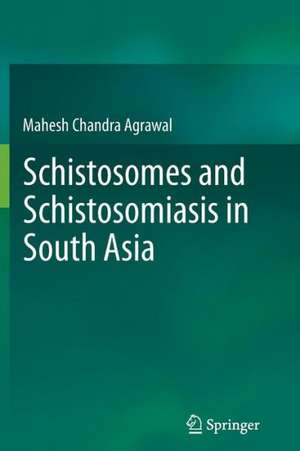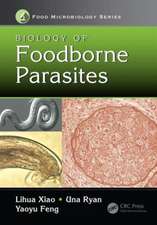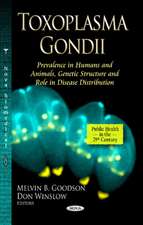Schistosomes and Schistosomiasis in South Asia
Autor Prof. Mahesh Chandra Agrawalen Limba Engleză Paperback – 10 iun 2014
| Toate formatele și edițiile | Preț | Express |
|---|---|---|
| Paperback (1) | 942.27 lei 6-8 săpt. | |
| Springer India – 10 iun 2014 | 942.27 lei 6-8 săpt. | |
| Hardback (1) | 952.09 lei 6-8 săpt. | |
| Springer India – 22 mai 2012 | 952.09 lei 6-8 săpt. |
Preț: 942.27 lei
Preț vechi: 1149.11 lei
-18% Nou
Puncte Express: 1413
Preț estimativ în valută:
180.29€ • 188.26$ • 148.89£
180.29€ • 188.26$ • 148.89£
Carte tipărită la comandă
Livrare economică 15-29 aprilie
Preluare comenzi: 021 569.72.76
Specificații
ISBN-13: 9788132217268
ISBN-10: 8132217268
Pagini: 364
Ilustrații: XII, 352 p.
Dimensiuni: 155 x 235 x 19 mm
Greutate: 0.51 kg
Ediția:2012
Editura: Springer India
Colecția Springer
Locul publicării:New Delhi, India
ISBN-10: 8132217268
Pagini: 364
Ilustrații: XII, 352 p.
Dimensiuni: 155 x 235 x 19 mm
Greutate: 0.51 kg
Ediția:2012
Editura: Springer India
Colecția Springer
Locul publicării:New Delhi, India
Public țintă
ResearchCuprins
Chapter 1: Introduction.- Chapter 2: The Schistosomes.- Chapter 3: The Snail.- Chapter 4: Prevalence in Final Host.- Chapter 5: Immunological Studies.- Chapter 6: Disease Manifestation and Pathology.- Chapter 7: Diagnosis of Schistosomiasis. Chapter 8: Immuno-diagnosis of Schistosomiasis.- Chapter 9: Chemotherapy.- Chapter 10: Control of Schistosomiasis.- Chapter 11: Laboratory Models Developed.- Chapter 12: Technologies Developed.
Textul de pe ultima copertă
Through all of the recent progress and publications on Schistosoma haematobium, S. mansoni and S. japonicum and diseases these parasites cause in human beings – engulfing Africa, South America and East Asia, it has become necessary to fill the gaps from South Asia perspective too, especially India from where many mammalian schistosome species have been discovered namely Schistosoma indicum, and S. spindale, S. nasale, S. incognitum, Orientobilharzia dattai, O. bomfordi, and Bivitellobilharzia nairi.
The history of schistosomes and schistosomiasis in Indian continent is more than hundred years old and a lot of research has been done to understand the infection in South Asian region. Authoritative and concise, Schistosomes and Schistosomiasis in South Asia covers all aspects of these schistosomes starting from taxonomy to life cycle, epidemiology, immunity, pathology, diagnosis (both parasitic and immunological diagnosis), chemotherapy and control. The book covers not only hepatic and nasal schistosomiasis in animals but also all the details on human schistosomiasis reported from this continent. There are also chapters which cover on experimental schistosome infections in laboratory animals and technologies developed for studying schistosomiasis.
The history of schistosomes and schistosomiasis in Indian continent is more than hundred years old and a lot of research has been done to understand the infection in South Asian region. Authoritative and concise, Schistosomes and Schistosomiasis in South Asia covers all aspects of these schistosomes starting from taxonomy to life cycle, epidemiology, immunity, pathology, diagnosis (both parasitic and immunological diagnosis), chemotherapy and control. The book covers not only hepatic and nasal schistosomiasis in animals but also all the details on human schistosomiasis reported from this continent. There are also chapters which cover on experimental schistosome infections in laboratory animals and technologies developed for studying schistosomiasis.
Caracteristici
There is no book which deals with South Asian schistosomiasis and this book will be first on the subject
To international scientific community, WHO ,FAO, this book will provide an authenticated document with critical review all the work carried out in Indian continent since discovery of schistosomes from the geography i.e. 1882 and 1906
No book has ever been published covering schistosomes and schistosomiasis in South Asia hence there is no question of competition
Will be the only book which will be referred by the scientists, research scholars, policy makers, etc for updating their knowledge on the disease in this geography
To international scientific community, WHO ,FAO, this book will provide an authenticated document with critical review all the work carried out in Indian continent since discovery of schistosomes from the geography i.e. 1882 and 1906
No book has ever been published covering schistosomes and schistosomiasis in South Asia hence there is no question of competition
Will be the only book which will be referred by the scientists, research scholars, policy makers, etc for updating their knowledge on the disease in this geography





